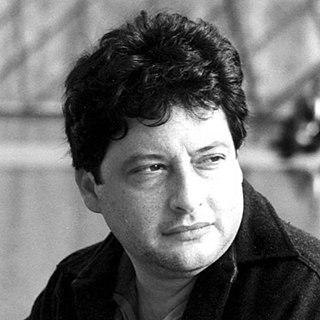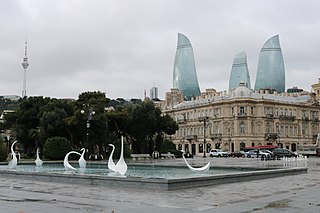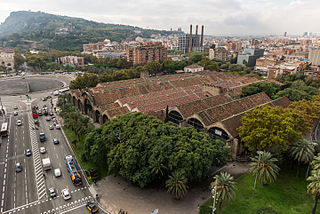
Porthcawl is a town and community on the south coast of Wales in the county borough of Bridgend, 25 miles (40 km) west of the capital city, Cardiff and 19 miles (31 km) southeast of Swansea. Historically part of Glamorgan and situated on a low limestone headland on the South Wales coast, overlooking the Bristol Channel, Porthcawl developed as a coal port during the 19th century, but its trade was soon taken over by more rapidly developing ports such as Barry. Northwest of the town, in the dunes known as Kenfig Burrows, are hidden the last remnants of the town and Kenfig Castle, which were overwhelmed by sand about 1400.

Toyo Ito is a Japanese architect known for creating conceptual architecture, in which he seeks to simultaneously express the physical and virtual worlds. He is a leading exponent of architecture that addresses the contemporary notion of a "simulated" city, and has been called "one of the world's most innovative and influential architects."

Roberto Burle Marx was a Brazilian landscape architect whose designs of parks and gardens made him world-famous. He is accredited with having introduced modernist landscape architecture to Brazil. He was known as a modern nature artist and a public urban space designer. His work had a great influence on tropical garden design in the 20th century. Water gardens were a popular theme in his work. He was deftly able to transfer traditional artistic expressions such as graphic design, tapestry and folk art into his landscape designs. He also designed fabrics, jewellery and stage sets.

Wimereux (Dutch:Wimeruwe) is a commune in the Pas-de-Calais department in the Hauts-de-France region of France.

Newton's Cove is a small cove with sand, shingle and rock pools, 0.5 kilometres (0.3 mi) south of Weymouth, Dorset, England, overlooking Portland Harbour and next to the Nothe Fort. The beach is mainly used by locals and by tourists who visit the Nothe Gardens and the fort.

Alejandro Zaera Polo is a Spanish-born American contemporary architect and founder of London and New York based Alejandro Zaera-Polo & Maider Llaguno Architecture (AZPML). He is the former dean of the School of Architecture at Princeton University for two years and a prolific theorist, widely published in different professional media.
Vicente Guallart is a Spanish architect. He was the Chief Architect of Barcelona City Council between 2011 and 2015.

Andrés Mignucci FAIA is a Puerto Rican architect and urbanist. His work has received recognition for its integration of the disciplines of architecture, urban design and landscape architecture in the creation of public spaces with a sense of place, human scale, and environmental responsibility. In 2005 Andrés Mignucci was elected to the College of Fellows of the American Institute of Architects. In 2012, he was awarded the Henry Klumb Award by the Puerto Rico College of Architects. In 2019, Mignucci received the Distinguished Professor Award by the Association of Collegiate Schools of Architecture, and was named Arts and Literary Arts Scholar in Residence at the Rockefeller Foundation's Bellagio Center in Bellagio, Italy.
Aaron Betsky, director of Virginia Tech's School of Architecture + Design, is a widely published critic on art, architecture and design. Trained as an architect and in the humanities at Yale University, he is the author of over a dozen books, including Architecture Matters, Making It Modern, Landscrapers: Building With the Land, Scanning: The Aberrant Architectures of Diller + Scofidio, Queer Space, Revelatory Landscapes, and Architecture Must Burn. Internationally known as a lecturer, curator, reviewer and commentator, he writes the blog "Beyond Buildings" for architectmagazine.com. Director of the 11th Venice Architecture Biennale, he has also been President and Dean of the School of Architecture at Taliesin ,director of the Netherlands Architecture Institute (2001-2006) and of the Cincinnati Art Museum (2006-2014), and was founding Curator of Architecture, Design and Digital Projects at the San Francisco Museum of Modern Art (1995-2001). As an architect, he worked for Frank O. Gehry & Associates and Hodgetts + Fung. At the Whitney Museum of American Art in 2003 he co-curated "Scanning: The Aberrant Architectures of Diller + Scofidio." Born in Montana, he grew up there and in the Netherlands.

Wilhelmus "Winy" Maas is a Dutch architect, landscape architect, professor and urbanist. In 1993 together with Jacob van Rijs and Nathalie de Vries he set up MVRDV. Early work such as the television centre Villa VPRO and the housing estate for elderly WoZoCo, both in the Netherlands, have brought him international acclaim and established MVRDV’s leading role in international architecture. Winy Maas is married to Mirjam Veldhuizen van Zanten. They live in Rotterdam, Netherlands and have three sons.
Professor Jacob van Rijs Ir. FRIBA is architect, urban planner and one of MVRDV’s three founding partners. Besides giving lectures worldwide van Rijs is also professor Entwerfen und Baukonstruktion at the Technical University of Berlin. Moreover, he regularly lectures and takes part in student juriesat universities and institutes worldwide. His teaching experience comprehends TU Munich, TU Delft, University of Wismar, ETSAM University Madrid, Royal Academy of Arts Copenhagen, Tokyo Institute of Technology and Rice University, Houston, amongst others. Within the Royal Institute of Dutch Architects (BNA) he is chairman of the International Programme, creating a better support and stimulation for Dutch architects in their activities across the border worldwide. He also holds a position in the Dutch Trade and Investment Board (DTIB) from where he represents architects an international trade and investment level.

Diagonal Mar i el Front Marítim del Poblenou is a neighborhood in the Sant Martí district of Barcelona, Catalonia, Spain.

Baku Boulevard is a promenade established in 1909 which runs parallel to Baku's seafront. Its history goes back more than 100 years, to a time when Baku oil barons built their mansions along the Caspian shore and when the seafront was artificially built up inch by inch.

The 1929 Barcelona International Exposition was the second World Fair to be held in Barcelona, the first one being in 1888. It took place from 20 May 1929 to 15 January 1930 in Barcelona, Spain. It was held on Montjuïc, the hill overlooking the harbor, southwest of the city center, and covered an area of 118 hectares at an estimated cost of 130 million pesetas. Twenty European nations participated in the fair, including Germany, Britain, Belgium, Denmark, France, Hungary, Italy, Norway, Romania and Switzerland. In addition, private organizations from the United States and Japan participated. Latin American countries as well as the United States were represented in the Ibero-Americana section in Sevilla.

The Barcelona Royal Shipyard is a shipyard and former military building of Gothic architecture placed at the Port Vell area of the Port of Barcelona. Nowadays it houses the Barcelona Maritime Museum. Construction started during the 13th century under the rule of Peter III of Aragon. During excavations in 2012 it was discovered that in the late 16th century a new building was constructed on top of the old medieval dockyard, giving the building its current structure. This excavations also uncovered a Roman graveyard. The shipyard's restoration was finished in early 2013. The museum was reopened in 2014.

The St Andrews Beach House is a residential building located on St Andrews Beach in Victoria, Australia. Designed by Australian architect Sean Godsell, the house was awarded the Robin Boyd Award in 2006.
Greenstein Har-Gil, Landscape Architecture Ltd is an Israeli landscape architecture firm.

The following outline is provided as an overview of and topical guide to Barcelona:

Teresa Gali-Izard is a Spanish landscape architect, agronomist and professor of landscape architecture.

















